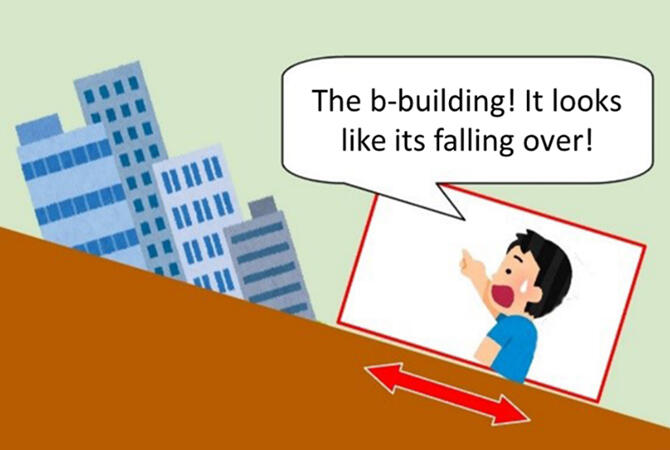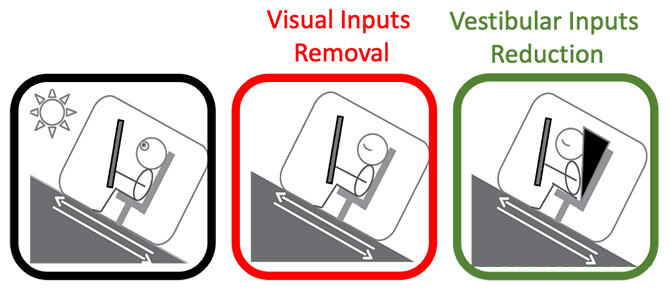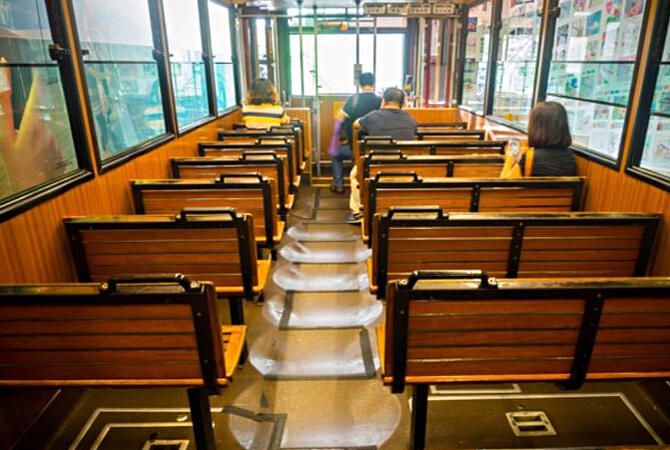Playing a trick on someone's eyes is commonly referred to as an optical illusion. It is strange and interesting phenomenon, where figures and patterns appear to distort and move, tricking the senses. Hong Kong's famous trams create a unique optical illusion in which the surrounding buildings appear to lean instead of standing straight. Local experiments have shown that the underlying mechanism is a result of the body of the seated passenger being in a tilted position due to the structure of the vehicle, causing it to travel in a tilted position. Surprisingly, the visual impact is small.

(courtesy of Tohoku University and Tohoku Gakuin University).
The buildings lean when the tram moves!?
The ability to perceive verticality is essential for daily activities and safety, such as in walking and driving. Sometimes this ability does not function correctly, and an optical illusion occurs. An international research group with members from Tohoku University, Tohoku Gakuin University, and others, have tried to shed some light on the mechanism of this. They focused on the optical illusion created by a tram ride to Victoria Peak, a scenic spot in Hong Kong, in which the surrounding buildings appear to tilt when the car is in motion.

The researchers prepared a rod‐shaped instrument to check the difference between the vertical direction of gravity and the direction that people perceived verticality (subjective haptic vertical). Eight adult test subjects rode the tram, and an experiment was conducted using the device. First, when they sat down in the tram with their eyes open and looked around, the misperception increased as the slope became steeper while moving. The same was true whether riding uphill or downhill.
It should be noted that tram floors are generally stepped like a staircase, but the ones in this region are flat, as are railways that run on level ground, and the seats are installed so that they are level with the floor. The seats are fixed so that they always face upward.
Closing your eyes does not change the misperception
The next step was to conduct an experiment to determine the source of the misperception. Whether the subjects rode the tram with their eyes closed or with an object clipped to the back of the seat so that the body axis stood in the direction of gravity, the misperception was the same as when they rode the tram with their eyes normally open. In other words, neither vision nor the sensation of the vestibular system, organs in the inner ear that sense body inclination, was found to be the main cause of the illusion.

(courtesy of Tohoku University and Tohoku Gakuin University).
No issue was found when the study was conducted indoors in a non‐mobile reclining chair, sitting in an upright position, and only leaning backwards. There was similarly no misperception when sitting on a tram travelling on level ground.
The results of this study revealed that the combination of two factors, the body pitching and moving at the same time, causes the illusion of a shift in vertical perception and the building appears to tilt. The two factors have often been studied separately, but the illusion is caused by a combination of these factors.
Applications for amusement parks, rehabilitation and information and communication
Kenzo Sakurai, Professor of Perceptual Psychology at the Faculty of Liberal Arts at Tohoku Gakuin University, and a member of the research group, explained, "If the vertical you perceive is tilted backwards, you will probably see a building standing vertically with a correction, making it appear to be tilted." He notes that the results of the group's research could lead to technology that distorts vertical perception, which could be applied to amusement parks and other forms of entertainment, rehabilitation of bodily functions such as fall prevention, and information and communication.
Chua‐Huei Tseng, Associate Professor of Visual Cognition and Systems at the Research Institute of Electrical Communication at Tohoku University, said, "Most optical illusion research is conducted in strictly controlled laboratories, but in this case, we were only able to make our discovery in an outdoor vehicle. Unlike most trams in Japan and other countries, this vehicle is tilted, and the surrounding buildings are close together, making it easy to create an optical illusion, which was useful for the research."
The research group is comprised of Tohoku University, Tohoku Gakuin University, the University of St Thomas in Canada, the University of Freiburg in Germany and the University of Leipzig. The group's results were published in the electronic edition of the Dutch journal Multisensory Research on the 21st of December 2022, and announced by Tohoku University and others on the 26th.

(courtesy of Tohoku University and Tohoku Gakuin University).
I also rode this tram a long time ago, but unfortunately have no recollection of the optical illusion, perhaps because I was too preoccupied by the 'green tea with honey,' which was widely sold in the area. According to Japanese living in the area, this green tea is perplexing at first, but once you get used to it, you will feel that others are missing out. This made me think of how complex and profound the human senses are, both in terms of optical illusions and taste.
Journal Information
Publication: Multisensory Research
Title: Body Pitch Together with Translational Body Motion Biases the Subjective Haptic Vertical
DOI: 10.1163/22134808‐bja10086
(KUSAKA Takeo / Science Portal Editorial Office)
Original article was provided by the Science Portal and has been translated by Science Japan.




